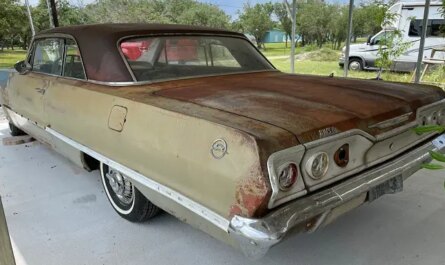The 1987 Chevrolet Nova was a compact car introduced by General Motors as part of the fifth generation of the Chevrolet Nova series. This model marked a significant departure from the earlier Nova iterations, as it was a joint venture between General Motors and Toyota. The collaboration resulted in the production of a fuel-efficient, reliable, and affordable vehicle that appealed to a wide range of consumers. In this comprehensive review, we will explore the history, design, performance, and legacy of the 1987 Chevrolet Nova, highlighting the features that made it stand out in the competitive compact car market of the 1980s.
A Brief Overview of the Chevrolet Nova Series
The Chevrolet Nova was first introduced in 1962 as a compact car designed to compete with the influx of smaller, affordable vehicles from Europe and Japan. The first four generations of the Nova (1962-1979) were characterized by their rear-wheel-drive layout, V8 engine options, and simple, utilitarian design.
After a brief hiatus, the Nova nameplate was revived in 1985 with the introduction of the fifth-generation model. Unlike its predecessors, the fifth-generation Nova was a front-wheel-drive compact car developed through a partnership between General Motors and Toyota, known as the New United Motor Manufacturing, Inc. (NUMMI). This joint venture aimed to combine the best of both American and Japanese automotive engineering, resulting in a car that was both practical and attractive to consumers in a rapidly changing automotive market.
Design and Styling of the 1987 Chevrolet Nova
The 1987 Chevrolet Nova was designed with simplicity and functionality in mind. Its exterior featured clean lines and a relatively boxy shape, which was typical of compact cars from the 1980s. The Nova was available in two body styles: a four-door sedan and a five-door hatchback, offering versatility for different consumer needs. The interior of the Nova was spacious for a compact car, providing comfortable seating for up to five passengers and ample cargo space, especially in the hatchback version.
The interior design of the 1987 Nova was straightforward and uncluttered, with easy-to-read gauges and clearly labeled controls. The dashboard layout was reminiscent of Toyota’s design language, reflecting the influence of the NUMMI partnership. The materials used in the interior were of good quality for a car in its price range, providing a pleasant and durable environment for passengers.
Performance and Handling of the 1987 Chevrolet Nova
The 1987 Chevrolet Nova was powered by a 1.6-liter inline-four engine, which was based on Toyota’s 4A engine family. The engine produced 74 horsepower and 85 lb-ft of torque, providing adequate power for a compact car of its time. Two transmission options were available: a five-speed manual or a three-speed automatic, both of which were designed to offer smooth and precise gear changes.
The Nova’s front-wheel-drive layout and independent suspension provided a comfortable and composed ride, with good handling characteristics for a car in its class. The steering was light and responsive, making the Nova easy to maneuver in tight spaces and urban environments. The car’s fuel economy was also a strong selling point, with EPA ratings of up to 30 miles per gallon in the city and 37 miles per gallon on the highway, depending on the transmission choice.
Safety features on the 1987 Chevrolet Nova included front disc brakes, rear drum brakes, and a driver’s side airbag, which was still a relatively new technology at the time. The Nova also featured a high-strength steel body structure, designed to provide good crash protection for occupants.
Trim Levels and Options for the 1987 Chevrolet Nova
The 1987 Chevrolet Nova was available in two trim levels: Base and CL. The Base model was equipped with standard features such as cloth seats, a rear window defroster, and an AM/FM radio. The CL trim added extra amenities, including upgraded cloth upholstery, a center console with storage, and full wheel covers.
Optional equipment on the Nova included air conditioning, power steering, power brakes, and a tilt steering wheel. Buyers could also choose from a variety of audio systems, ranging from a basic AM/FM radio to a premium AM/FM cassette stereo with equalizer.
The Legacy of the 1987 Chevrolet Nova
The 1987 Chevrolet Nova marked a turning point in the history of the Nova nameplate, as it transitioned from a traditional American compact car to a modern, fuel-efficient vehicle with global influences. The NUMMI partnership between General Motors and Toyota proved to be a successful venture, with the Nova receiving positive reviews for its reliability, practicality, and value.
Though the Chevrolet Nova was discontinued after the 1988 model year, its legacy lived on in the Geo Prizm, a badge-engineered version of the Toyota Corolla produced by the NUMMI joint venture. The Prizm continued the Nova’s tradition of offering affordable, reliable transportation to American consumers until its discontinuationin 2002.
Over the years, the 1987 Chevrolet Nova has gained a loyal following among classic car enthusiasts and collectors who appreciate its unique place in automotive history. With its blend of American and Japanese design and engineering, the Nova stands as a testament to the power of collaboration in the automotive industry.
Conclusion
The 1987 Chevrolet Nova was a significant departure from its predecessors, showcasing the benefits of a joint venture between General Motors and Toyota. Its simple, functional design, fuel-efficient performance, and reputation for reliability made it an attractive option for consumers in the competitive compact car market of the 1980s.
As a result, the 1987 Chevrolet Nova remains an interesting and noteworthy part of automotive history. Its unique combination of American and Japanese influences, as well as its role in the evolution of the Chevrolet Nova nameplate, make it a compelling subject for car enthusiasts and collectors alike.


